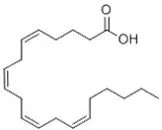| In vivo: |
| Environ Toxicol Chem. 2015 Mar;34(3):527-35. | | Arachidonic acid enhances reproduction in Daphnia magna and mitigates changes in sex ratios induced by pyriproxyfen.[Pubmed: 25393616] | Arachidonic acid is 1 of only 2 unsaturated fatty acids retained in the ovaries of crustaceans and an inhibitor of HR97g, a nuclear receptor expressed in adult ovaries. The authors hypothesized that, as a key fatty acid, Arachidonic acid may be associated with reproduction and potentially environmental sex determination in Daphnia.
METHODS AND RESULTS:
Reproduction assays with Arachidonic acid indicate that it alters female:male sex ratios by increasing female production. This reproductive effect only occurred during a restricted Pseudokirchneriella subcapitata diet. Next, the authors tested whether enriching a poorer algal diet (Chlorella vulgaris) with Arachidonic acid enhances overall reproduction and sex ratios. Arachidonic acid enrichment of a C. vulgaris diet also enhances fecundity at 1.0 µM and 4.0 µM by 30% to 40% in the presence and absence of pyriproxyfen. This indicates that Arachidonic acid is crucial in reproduction regardless of environmental sex determination. Furthermore, the data indicate that P. subcapitata may provide a threshold concentration of Arachidonic acid needed for reproduction. Diet-switch experiments from P. subcapitata to C. vulgaris mitigate some, but not all, of Arachidonic acid's effects when compared with a C. vulgaris-only diet, suggesting that some Arachidonic acid provided by P. subcapitata is retained.
CONCLUSIONS:
In summary, Arachidonic acid supplementation increases reproduction and represses pyriproxyfen-induced environmental sex determination in D. magna in restricted diets. A diet rich in Arachidonic acid may provide protection from some reproductive toxicants such as the juvenile hormone agonist pyriproxyfen. | | PLoS One. 2014 Feb 19;9(2):e89347. | | Arachidonic acid enhances turnover of the dermal skeleton: studies on zebrafish scales.[Pubmed: 24586706] | In fish nutrition, the ratio between omega-3 and omega-6 poly-unsaturated fatty acids influences skeletal development. Supplementation of fish oils with vegetable oils increases the content of omega-6 fatty acids, such as Arachidonic acid in the diet. Arachidonic acid is metabolized by cyclooxygenases to prostaglandin E2, an eicosanoid with effects on bone formation and remodeling.
METHODS AND RESULTS:
To elucidate effects of poly-unsaturated fatty acids on developing and existing skeletal tissues, zebrafish (Danio rerio) were fed (micro-) diets low and high in Arachidonic acid content. Elasmoid scales, dermal skeletal plates, are ideal to study skeletal metabolism in zebrafish and were exploited in the present study. The fatty acid profile resulting from a high Arachidonic acid diet induced mild but significant increase in matrix resorption in ontogenetic scales of adult zebrafish. Arachidonic acid affected scale regeneration (following removal of ontogenetic scales): mineral deposition was altered and both gene expression and enzymatic matrix metalloproteinase activity changed towards enhanced osteoclastic activity. Arachidonic acid also clearly stimulates matrix metalloproteinase activity in vitro, which implies that resorptive effects of Arachidonic acid are mediated by matrix metalloproteinases.
CONCLUSIONS:
The gene expression profile further suggests that Arachidonic acid increases maturation rate of the regenerating scale; in other words, enhances turnover. The zebrafish scale is an excellent model to study how and which fatty acids affect skeletal formation. |
|






 Cell. 2018 Jan 11;172(1-2):249-261.e12. doi: 10.1016/j.cell.2017.12.019.IF=36.216(2019)
Cell. 2018 Jan 11;172(1-2):249-261.e12. doi: 10.1016/j.cell.2017.12.019.IF=36.216(2019) Cell Metab. 2020 Mar 3;31(3):534-548.e5. doi: 10.1016/j.cmet.2020.01.002.IF=22.415(2019)
Cell Metab. 2020 Mar 3;31(3):534-548.e5. doi: 10.1016/j.cmet.2020.01.002.IF=22.415(2019) Mol Cell. 2017 Nov 16;68(4):673-685.e6. doi: 10.1016/j.molcel.2017.10.022.IF=14.548(2019)
Mol Cell. 2017 Nov 16;68(4):673-685.e6. doi: 10.1016/j.molcel.2017.10.022.IF=14.548(2019)